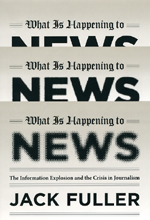What Is Happening to a Salon of One’s Own?

We’ve always has a soft spot for newsworthy (pun intended) online publications—so it’s no surprise that we read today’s headlines about Salon with a bit of chagrin. The San Francisco-based “Internet roundtable” has long been in the red—with losses of $15 million dollars in the past three years alone—but now the Wall Street Journal reports (a paid content item quickly picked up by the New York Observer) that the company is searching for a larger media company to partner with or to subsume its enterprises. While possible pairings that emerge during heroic acts of desperation (remember John Candy and Eugene Levy in Armed and Dangerous?) can be surprisingly generative (this past April, Salon formed a content-based micro-partnership with the popular literary independent McSweeney’s), it’s the changing circumstances, audiences, and even our clinical understanding around how we receive and are informed by the news that are applying pressure to traditional journalistic practices.
Salon has transformed itself quite a bit during its twelve-year run, from an innovative online news site helmed by information-driven posts and public forum op-eds to a more lifestyle-inclusive, audience-driven . . . well, salon. Experiments with subscription-based content have faltered and pushed them further into the red, but recent media headlines alone—from the Tribune Co.’s buyout and various lawsuits with its creditors to a potential merger between Newsweek and the Daily Beast—suggest big changes for online journalism. Speaking of which, shout out to longtime Baffler editor and Press author Thomas Frank’s powerful piece, “Bright Frenetic Mills,” in this month’s Harper’s on a world where bloggers break stories and bubbles, navigating a landscape shaped by content mills and the perilous position of old-fashioned journalism (an excerpt from Frank’s The Conquest of Cool: Business Culture, Counterculture, and the Rise of Hip Consumerism is available here).

Jack Fuller, a Pulitzer Prize-winning journalist who spent nearly forty years working in newspapers, including many as editor and publisher of the Chicago Tribune and president of the Tribune Publishing Company, might not have a perfect prediction as to what the future holds, but he certainly has some sharp ideas. What Is Happening to News: The Information Explosion and the Crisis in Journalism anticipates Frank’s polemic by exploring the crucial question of how journalism lost its way.
Fuller locates the surprising sources of change where few have thought to look before: in the collision between a revolutionary new information age and a human brain that is still wired for threats faced by our prehistoric ancestors. Sound impossibly suggestive? Check out an online excerpt from the book about the neuroscientific explanations behind twenty-first century info gathering here. And for more about how information overload, a growing distrust of experts and authority, and increasingly interactive media are changing the face of journalism as we know it, while still trying to provide the information necessary to a functioning democracy, don’t miss What Is Happening to News.
Wait, are we still live?